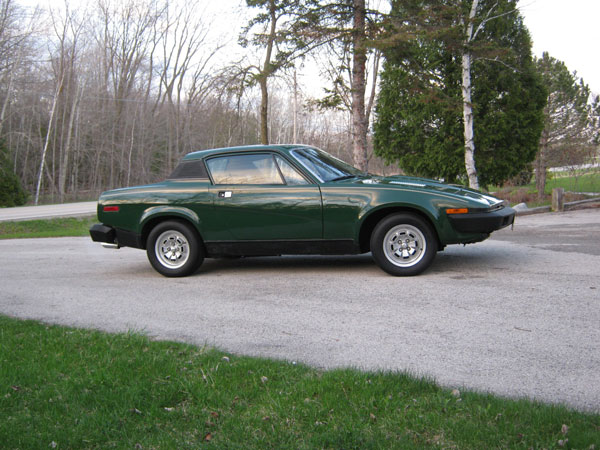
The last volume-produced traditional British roadster was the Triumph TR6. Even in 1969 when it was introduced, it was obsolete. Magazines such as Road & Track clamored for better, newer sports cars with modern engines, chassis and unibody construction—cars that would finally dispense with antiquated features like lever-action shocks and feeble heaters.
In early 1975, Triumph finally introduced such a car in the TR7, which would be sold alongside the TR6 for about a year. Dubbed in ads as “the shape of things to come,” the TR7 was the most extreme example of the wedge style then in vogue. Legend has it that stylist Harris Mann sketched the original design on a cocktail napkin (perhaps after too many cocktails). Generally regarded as less than pretty, the most unsuccessful portions of the design were the notchback roofline of the coupe and the upswept character line on the side.
Power came from a 2-liter, 8-valve, 4-cylinder overhead cam engine of about 100 horsepower that was, oddly enough, shared with the Saab 99. Strangely, experiments using the Dolomite Sprint’s 16-valve unit went nowhere. Acceleration was less than brisk—0–60 mph in about eleven seconds.
The design reverted from the independent rear suspension of the TR4A/TR6 models to a well-located live axle. Although this seemed like a retrograde step, in light of the generally mediocre design of the previous IRS, it wasn’t, and the TR7 developed a reputation as a very good handler on the street and the track—most famously with Bob Tullius and Group 44 Racing.
TR7 lemon and TR8 lemonade?
However, the primary reputation the TR7 developed was that of a serious lemon. Early cars built in Speke near Liverpool were particularly bad, and the plant—which was subsequently closed—was the epicenter of the self-destructive tactics British labor deployed in the 1970s. Later cars built in Solihull were considerably better. Initially, the TR7 was available only in coupe form because of fears that the United States would outlaw convertibles. This never came to pass, and in 1979, a drophead version was added.
More significantly, Triumph addressed the lack of performance around the same time with the introduction of the TR8, which was powered by the aluminum 215-ci V8 engine found in Buicks, Oldsmobiles and Pontiacs (with versions used by various Land Rovers for many more years). Most of the 400 pre-production cars were automatic coupes. Amazingly, most of them were sold via the Jaguar-Rover-Triumph dealer network as used cars after the evaluation period ended. The TR8 was built for the 1981 and 1982 model years. All California cars were Bosch fuel-injected, as were all 1982 cars. The rest had a pair of Zenith-Stromberg carburetors. Only 2,700 were built, most in somewhat odd metallic colors ranging from green to aqua. Many had very period plaid seats.
The TR7/8 cockpit is reasonably comfortable. Wider and more spacious than the TR4 to TR6 cars, it also had far less character. Gone was the wood dash, replaced by a nondescript, plastic affair that could have come from any contemporary sedan. At least ventilation was greatly improved, and a/c was available. Ride, handling, braking and fuel economy were deemed excellent by Road & Track, who said “the only other thing we could ask for is good looks.”
Numerous special edition TR7s were built, including the “Victory Edition” with garish stripes and white “spoker” wheels and the altogether more handsomer “Spyder” edition with black paint, red accents and TR8 alloy wheels. Individual vices mostly came from the abysmal quality control of early cars. Thankfully, like similarly afflicted early Jaguar XJS models, most of these cars have disappeared, becoming one with the earth at various breaking yards around the world.
Rust, head gaskets and overheating
4- and 8-cylinder cars suffered the usual rust maladies and overheating issues—but not to the extent of earlier TRs. The 4-cylinder cars had head gasket troubles as well. From a parts-support standpoint, things aren’t nearly as rosy as they are for separate-body-and-chassis TRs and Spitfires. Lack of popularity and low survivorship are the reasons.
The collectability equation is interesting. It would seem that the TR8 is long overdue for a market-bump. The car’s 8-cylinder performance, combined with a drop top and genuine rarity, bodes in its favor. An abysmal (and somewhat undeserved) reputation for unreliability, as well as the controversial wedge styling (somewhat mitigated in drophead form), are probably responsible for the lack of interest thus far.
But, as with the Sunbeam Tiger of the 1960s, there is much to like about the TR8. TR7s will remain somewhat hopeless indefinitely, with the supply of decent coupes nearly zero and convertibles perennially occupying the same lowest-of-the-low rung as Fiat Spider 2000s and rubber bumper MG Midgets.